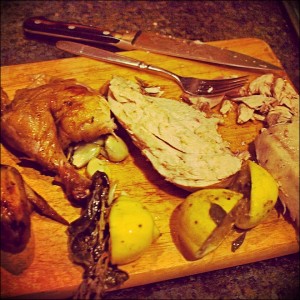 Or, “What I learned by not eating bread, pasta, rice, tortillas, milk, yogurt, cheese, beans, butter, potatoes, lentils, granola, cookies, crackers, chips, cereal, oatmeal, pancakes, waffles, peanut butter, or soy sauce.”
Or, “What I learned by not eating bread, pasta, rice, tortillas, milk, yogurt, cheese, beans, butter, potatoes, lentils, granola, cookies, crackers, chips, cereal, oatmeal, pancakes, waffles, peanut butter, or soy sauce.”
When I first heard about the Paleolithic Diet a couple years ago, I thought it was for hard-bodies (my CrossFit friends) and slightly deranged people only. For those of you who aren’t familiar with the Paleo diet (also called the Stone Age diet, caveman diet, and hunter-gatherer diet), the premise is to eat only foods that theoretically would have been available to our pre-agricultural ancestors — foods that, for the most part, could be either foraged for or hunted. Basically that’s meat, fish, vegetables, fruits, and nuts. The theory is that humans are not adapted to eat processed grains (bread, pasta, Wheat Thins), dairy products, sugar, or foods that require cooking (rice, potatoes, beans), so therefore eating these foods (and a lot of others on the Paleo no-no list) is bad for our health for a variety of reasons.
Paleo proponents believe that our modern diet is a major cause of many “diseases of affluence,” including heart disease, obesity, cancer, and diabetes — diseases that have been linked to our Western lifestyle, not necessarily to having money, by the way. So, the Paleo theory goes, if we were to stick to eating what we’re genetically programmed to eat, we would be as hale and hearty as our Paleolithic ancestors. Many anthropologists and nutritionists take issue with some of the science behind the Paleo diet (Like: We’ve had over 10,000 years since the dawn of the agricultural era; plenty of time to evolve! And: Hey, cave dwellers actually did get cancer, that is if they lived long enough and didn’t die of a snake bite or saber-tooth tiger attack first!), and there are some who label it a fad.
Until recently, I was in that “fad” camp. First, eating Paleo goes against just about everything I had ever known about what “healthy” food is — seriously, meat is okay but beans are bad? Most “health-conscious” food writers — from Andrew Weil to Heidi Swanson to Mark Bittman — encourage us to limit red meats and eat more wholesome whole grains and legumes. And while I’m aware of recent studies showing that saturated fats are good for us, and I realize that the highly processed grains most of us eat nowadays are not, I was still having a hard time wrapping my mind around a diet that tells you to give up black beans in favor of steak.
I’ve heard many, many firsthand stories of people improving their skin, weight, and overall health by adapting a Paleo diet (this website has a lot of nutritional info and explains the health claims better than I can). But while I’m all for eating for maximum health, I generally don’t advocate strictly avoiding anything unless you’ve got food allergies or sensitivities (well, except processed junk). As a person who enjoys good food and loves to cook, eating like a caveman never sounded like very much fun to me. In the words of some very wise hedonist, “You might live forever, but it will seem like it.” I mean, it’s all very interesting, but…did you get a look at that list of foods you can’t eat? I’m sorry, but I decided food lovers just can’t be Paleo.
Then my darling husband told me he’d decided to go Paleo.
“Huh?”I said.
Then I figured I might as well try it with him because, well, we’re married and we usually eat at least one or two meals per day together. Plus, I didn’t think it would last. Well…I haven’t been strict about it, but I have mostly avoided grains, sugar, potatoes, beans, and dairy products for about six weeks (I already avoided processed foods, too.) The forced scarcity made me finally drop the 5 lbs. that had been bugging me for, oh, about eight years. My husband, who’s not a big guy, has lost a lot more. Other health improvements noted around here recently include the disappearance of chronic knee pain and swelling, fewer stomach issues, lower cholesterol, better sleep. Hmmm.
A true Paleolithic diet is probably too restrictive for most people (including me) to sustain in the long term, but I think going Paleo, or in my case, “partly Paleo,” is a worthwhile thing to do. I know, I know, purists will say that “partly Paleo” is bogus and kind of meaningless, but “partly Paleo” is my plan for a while. I’ve not become deranged, and I’m not turning this into a Paleo blog, but I thought I would share that I’m going in this direction. In the last week, I’ve added back in a few items — corn tortillas, Greek yogurt, Parmesan, lentils — that, for me at least, make life infinitely better and easier. I also understand some Paleo people have a “cheat day” occasionally, which is good because I helped my daughter finish off her chocolate bunny last night.
What I like about the Paleo diet is it forces you to eat mindfully. You really have to think about things when you can’t automatically stick your hand into a box of crackers every time you feel hungry or boil a pot of pasta when you’re uninspired at dinnertime. I discovered that I don’t even miss some things I thought I couldn’t live without (rice) and that I do really, really do miss others (coffee with cream). I learned that I can survive an afternoon sugar fix without chocolate (thanks to organic dried mango, my borderline-Paleo-approved sweet crutch) and that thinly sliced eggplant makes a killer substitute for pasta.
I also learned that the Paleo diet is actually not a bacon-and-pork chop free-for-all. The focus is on eating lots and lots of organic produce with the addition of some high-quality grass-fed meats, wild fish, and poultry. It seems a bit pricey, especially at the beginning when you’re running to the store every day for more perishable food. But then again, cutting out processed (packaged) foods will save money in the long run. Plus, I’ve always strongly believed we should stop eating industrially raised food, and this is by far the surest way to do that.
Planning is a necessity. I’ve talked a lot on this blog about meal planning (I sell wonderful Meal Plans by the way), but this goes way beyond that. Paleo folks need to plan breakfasts and snacks, too. This morning, I saw my husband make a little bag of raw almonds and dried strawberries to take to the office. This is new.
I expected to be hungry all the time, and I’m not. Ever. And — seeing as how I believe there’s more to eating than feeding ourselves, that eating should a source of pleasure, and that sharing enjoyable meals is one of life’s great joys — I also expected to be a little bored and depressed about the whole thing. But that hasn’t been the case at all. In fact, it’s been fun having my husband in the kitchen and experimenting together. Obviously, he’s taken a huge interest in meals lately (Honey, is this broccoli organic? he asked me! And, “Was this a happy chicken?”), and we’ve come up with some pretty creative and tasty alternatives to the starches and grains that have always filled our plates.
I’ve actually come full circle in my thinking and now believe that food lovers absolutely can be Paleo.
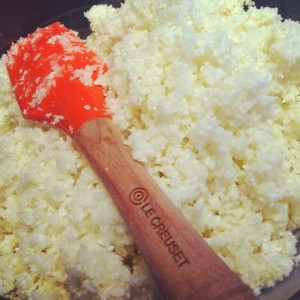 This recipe for Cauliflower Couscous is one of our most successful experiments. It’s delicious and very satisfying, and even the not-yet-Paleo kids said it was “yummy.” (By the way, we are moving our kids in this direction, too, without even telling them. But that’s a story for another post.) Last night I almost refrained from putting a big spoonful on my plate because it seemed so much like a high-carb starch. Weird.
This recipe for Cauliflower Couscous is one of our most successful experiments. It’s delicious and very satisfying, and even the not-yet-Paleo kids said it was “yummy.” (By the way, we are moving our kids in this direction, too, without even telling them. But that’s a story for another post.) Last night I almost refrained from putting a big spoonful on my plate because it seemed so much like a high-carb starch. Weird.
Cauliflower Couscous
This makes a great side dish just like this, or you can leave out the veggies and use the basic “couscous” as a vehicle for curry sauce. It goes great with stir-fries, and it can also be used for a killer Paleo “fried rice.” You don’t absolutely need a food processor for this, but it makes it a LOT easier.
Ingredients
1 head organic cauliflower, rinsed and fairly dry
2 tbs. olive oil (or coconut oil)
1/4 organic onion, chopped
1 clove garlic, minced
1-2 small organic zucchinis, diced
1 tsp. dried cumin
Salt & pepper
Cut the cauliflower into florets. The easiest way to do this is to cut the whole thing down the middle, right through the stem. Then cut the florets from the core. I’ve found this recipe works best if the florets are pretty close to the same size, so cut the larger pieces in half. Put a large handful of cauliflower in the food processor and pulse about 10-15 times until the cauliflower is the consistency of rice. Don’t over process or you’ll move into “mashed potato” territory (although that probably would not be the worst thing…). Transfer to a bowl and repeat until you’ve processed all the cauliflower.
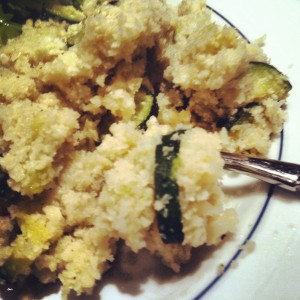 Heat the oil in a large skillet over medium-high heat. Add the onions and saute until soft and translucent, about 10 mins. Then add the garlic and zucchini and saute until slightly browned. Turn up the heat slightly and add about 2 cups of the cauliflower, a pinch of cumin, and salt & pepper. Cook, stirring constantly, until heated through but not mushy. Add more salt & pepper to taste. Save the remaining uncooked cauliflower for another meal (one head makes a LOT).
Heat the oil in a large skillet over medium-high heat. Add the onions and saute until soft and translucent, about 10 mins. Then add the garlic and zucchini and saute until slightly browned. Turn up the heat slightly and add about 2 cups of the cauliflower, a pinch of cumin, and salt & pepper. Cook, stirring constantly, until heated through but not mushy. Add more salt & pepper to taste. Save the remaining uncooked cauliflower for another meal (one head makes a LOT).
So there you have it, my take on eating Paleo and my first Paleo recipe. What do you guys think of the whole caveman thing?

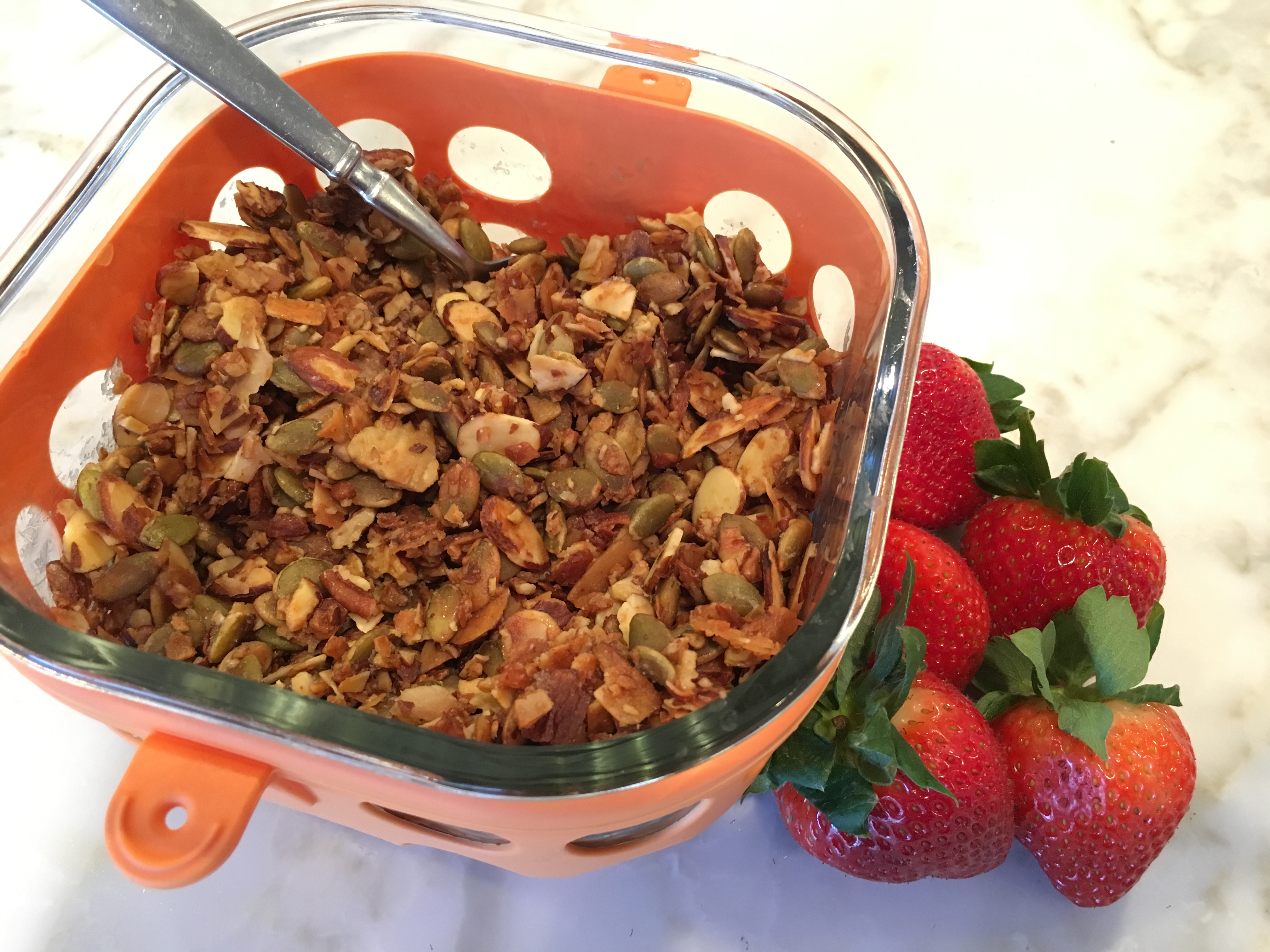
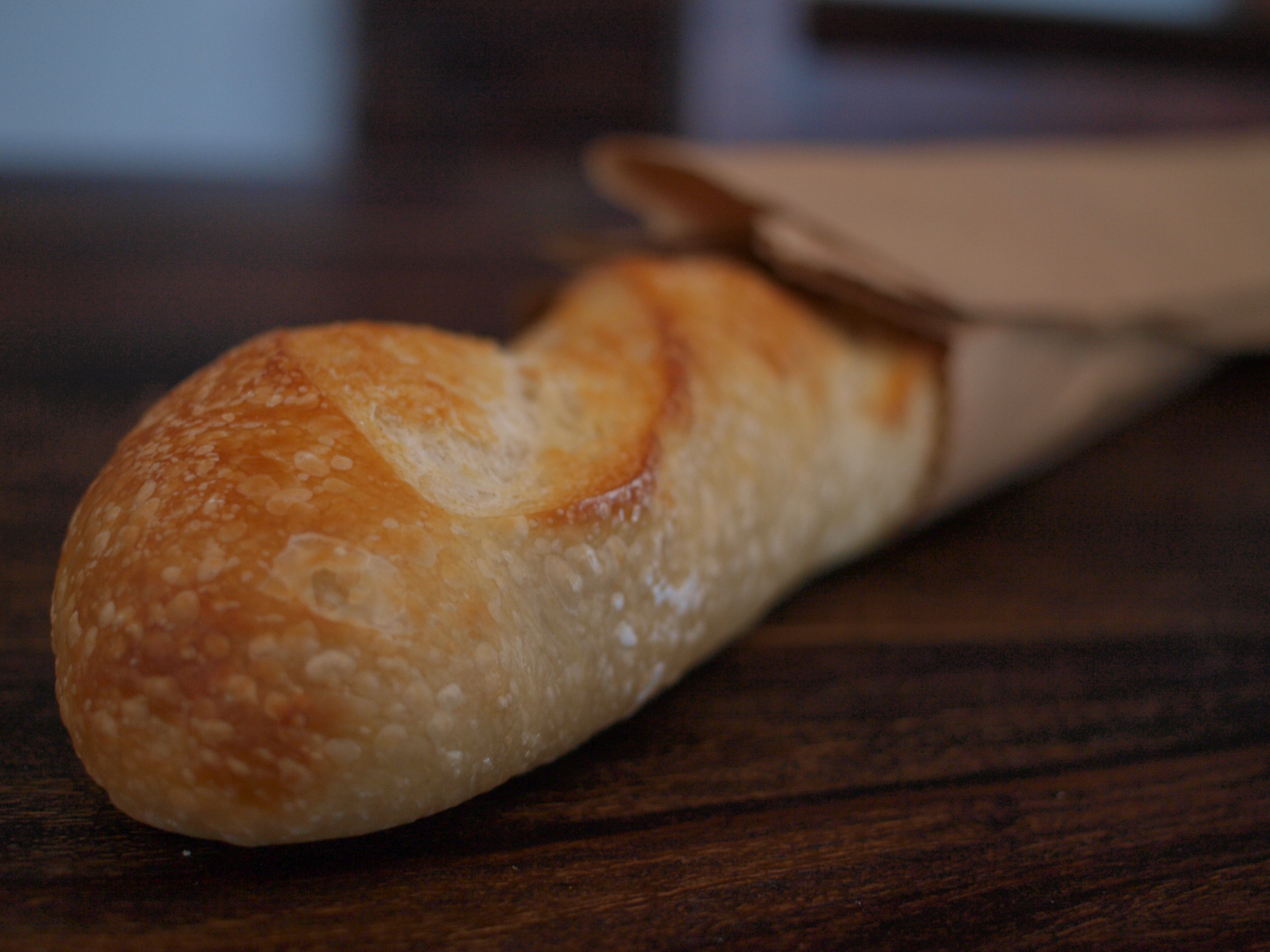
Love this post, Bevin. I’m going to try this recipe tonight. 🙂
Thanks Carrie!
We made this for the first time last week and have had it literally five times since then! Hope you’re well!
Bevin
Not to be too big of a ding-dong… but there’s no couscous in the couscous, correct? Real couscous is a grain, right? or is couscous a consistency? I’m going to try this. I’ve been wondering about the paleo thing. my neighbor lost a ton of weight and is a huge proponent and she says she’s never hungry.
Hello Mad Dog Mom,
Yes, I definitely should clarify that there is NO actual couscous in Cauliflower Couscous. Real couscous is definitely a grain (made from wheat, like pasta), and this is all about the consistency and side dish-ness of the recipe. Totally grain-free, try it!
My 2.5 years of paleo has bee a wonderful journey in the kitchen, researching what goes into my body, changing my paradigm of what’s healthy and what’s for breakfast.
I first switched to paleo because it made sense caloric-ly. I do not need 200 calories from bread or rice or a potato. Those foods do not have much nutritional value per calorie. I need 200 calories from broccoli!
Then I researched the scientific aspects that apply to muscles. Grains, legumes, potatoes and dairy, upon digestion, turn your blood acidic. Your body will take minerals or protein from your reserve storage sites (such as bones, muscle, or organs) to neutralize the excess acid.
Ok so that pre-race carbo load? Its robbing from my muscle mass the day before a race. I might as well eat a bag of cheetos.
Now I pass on pasta and load up on yams, cauliflower, and any veggie that’s in the fridge. I cook them in non-processed fats like olive or coconut oil. Wa La -healthy carbs.
Another side of Paleo that I really like, its sustainable and organic food bias. Paleo calls for organic fruits and veggies, and grass fed meats. This is environmentally sustainable. When you read about how grains and Kroger cows are raised, it will gross you out, and ruin the environment.
A wonderful vain benefit, is that you will build muscle mass, and use your fat to do it. My weight has not changed, but my pant size sure has! I can see my muscles (in a good way, not a creepy “too skinny” way).
I’m so into this way of eating, I could go on and on. There’s much more to discuss.
Here’s a great quick outline of why grains and legumes are not so good for us.
http://www.eat-real-food-paleodietitian.com/Paleo-diet-reasons-to-avoid-grains.html
Hi Liz,
Thanks so much for sharing your experience and knowledge about this! Believe me, I am well aware of the nastiness that is industrial farming, and we have been mostly organic and grass-fed for a while now.
By the way, what do you eat for breakfast???
Bevin